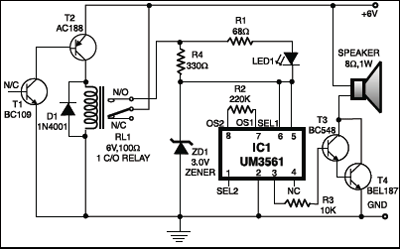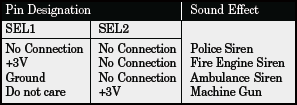 This automatic heat detector circuit uses a complementary pair comprising NPN metallic transistor T1 (BC109) and PNP germanium transistor T2 (AC188) to detect heat (due to outbreak of fire, etc) in the vicinity and energise a siren. The collector of transistor T1 is connected to the base of transistor T2, while the collector of transistor T2 is connected to relay RL1.
This automatic heat detector circuit uses a complementary pair comprising NPN metallic transistor T1 (BC109) and PNP germanium transistor T2 (AC188) to detect heat (due to outbreak of fire, etc) in the vicinity and energise a siren. The collector of transistor T1 is connected to the base of transistor T2, while the collector of transistor T2 is connected to relay RL1.
Automatic Heat Detector Circuit

The second part of the circuit comprises popular IC UM3561 (a siren and machine-gun sound generator IC). It can produce the sound of a fire-brigade siren. Pin numbers 5 and 6 of the IC are connected to the +3V supply when the relay is in energised state, whereas pin 2 is grounded. A resistor (R2) connected across pins 7 and 8 is used to fix the frequency of the inbuilt oscillator. The output is available from pin 3.
Two transistors BC147 (T3) and BEL187 (T4) are connected in Darlington configuration to amplify the sound from UM3561. Resistor R4 in series with a 3V zener is used to provide the 3V supply to UM3561 when the relay is in energised state. LED1, connected in series with 68-ohm resistor R1 across resistor R4, glows when the siren is on.
Construction & testing
To test the working of the circuit, bring a burning match stick close to transistor T1 (BC109). This causes the resistance of its emitter-collector junction to go low due to a rise in temperature and it starts conducting. Transistor T2 also conducts simultaneously, because its base is connected to the collector of transistor T1. As a result, relay RL1 energises and switches on the siren circuit to produce loud sound of a fire brigade siren.
Lab note
We have added a table to enable readers to obtain all possible sound effects by returning pins 1 and 2 as suggested in the table.

The article was first published in March 2005 and has recently been updated.






